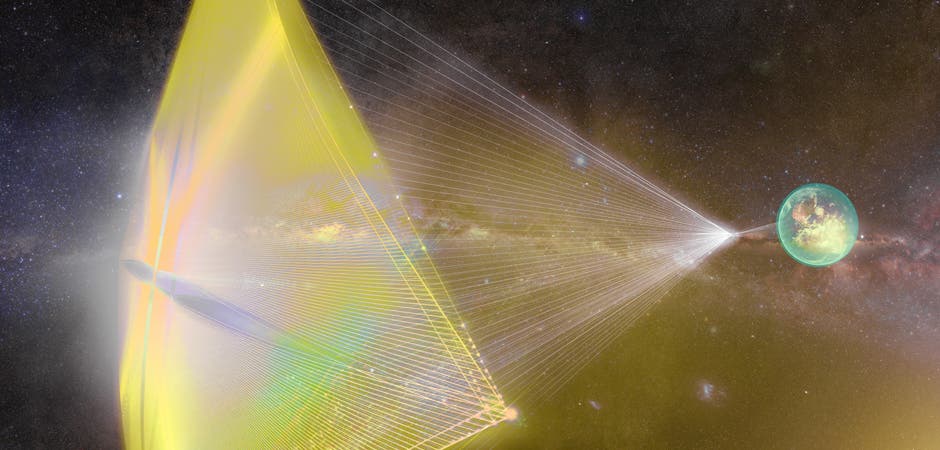A Russian billionaire wants to fund the first ever interstellar probe – and he wants to do it in the span of a generation. If this comes to fruition, it will be by far the most ambitious space endeavor ever attempted by mankind.

Image via Breakthrough Initiatives
Space is incredibly vast, we all know that, but sometimes it can be difficult to put things into perspective. The unit of measure for this type of distance is the light-year – the distance which light travels in vacuum in a whole year. The closest stars to our solar system, Alpha Centauri A and B, are approximately 4.22 light years away from US. The Sun is about 8 light minutes away, or 0.00001581 light years. Mars is even closer than that, so any mission to send something to another solar system is a whole level of difficulty above what we’re currently doing. But that’s exactly what Yuri Milner wants to do, and fast.
Yuri Milner is a Russian entrepreneur and venture capitalist with a background in physics. Many tech entrepreneurs have invested heavily into science, but Milner has distinguished himself from the pack. He made most of his cash from risky investments in social-media companies, including an 8 percent pre-IPO stake in Facebook. But before he was a billionaire, he studied physics in Moscow. He read the works of Isaac Asimov and Carl Sagan, falling in love with science fiction and of course – the science behind it. These days, he funds the most lucrative prize in science, with three annual awardees taking home $3 million dollars, more than twice the award granted to Nobel Prize Winners. Now he wants to go even further – where no man has gone before.
He calls himself a child of the space race – literally. Like many Russian kids in the 1960s, he was born after Yuri Gagarin, the first man to ever go to space. He wants to carry on the legacy of that name, and has put $100 million to fund research that will culminate in a prototype of a probe that can beam images back to Earth. It’s a high-risk/high-reward attempt, but if it works, we would be getting the first images from another solar system. We’d be getting them 5 years later than the ship’s arrival, but we’d be getting me.
According to the Atlantic, the proposed method of power for transportation would be a “light-sail,” a large reflective sheet that could reach cosmic speeds, when pushed with a powerful laser beam.
“The scientist that articulated this idea with a lot of scientific rigor was Robert Forward,” Milner told the Atlantic. Forward proposed a large mesh light-sail, measuring a full kilometer wide. He called it a “starwisp,” and he imagined a microwave beam could accelerate it to speeds that would put the local stars within reach.
“Forward’s idea was elegant, but it was unrealistic,” Milner said. “It would take a lot of energy, comparable to all the energy we have on our planet, to propel an enormous spacecraft like that. What we needed was a dramatic reduction in the size of a spacecraft. And by dramatic, I mean many, many orders of magnitude. We need to build a spacecraft that would weigh a few grams, together with the sail. If we can’t go down to a few grams, there is no conversation.”
The sail would only measure a few meters across, featuring miniaturized electronics onboard, including a power source, cameras, photon thrusters for navigation, and a laser for communication. This laser would have to be extremely powerful. It would have to generate 100 gigawatts of power for the two minutes needed to accelerate the butterfly probes to a fifth of the speed of light (subjecting its tiny innards to 60,000 times the force of normal gravity, by the way). That is about as much energy as it takes for a space shuttle to lift off. Almost goes without saying, such a laser doesn’t exist yet.
It’s all long and complicated, but they believe that everything can be solved one step at a time. Milner told me his team had looked into “20 challenges” that engineers will face, as they try to design this mission.
“Each one could have been a deal breaker,” he said. “But it looks like we found a reasonable path forward for each.” According to calculations, he’s got the money to push it all through. “That’s what the $100 million is for,” Milner said. “It’s to do extensive research into all of these challenges, and try to convince ourselves that this is possible in the lifetime of a single generation.”
There’s a lot of ‘ifs’ and ‘buts’, but at least it’s a start. Whether this will be successful or not, humanity is spreading its wings and reaching for the stars – literally. I for one, want to believe this will work out.









